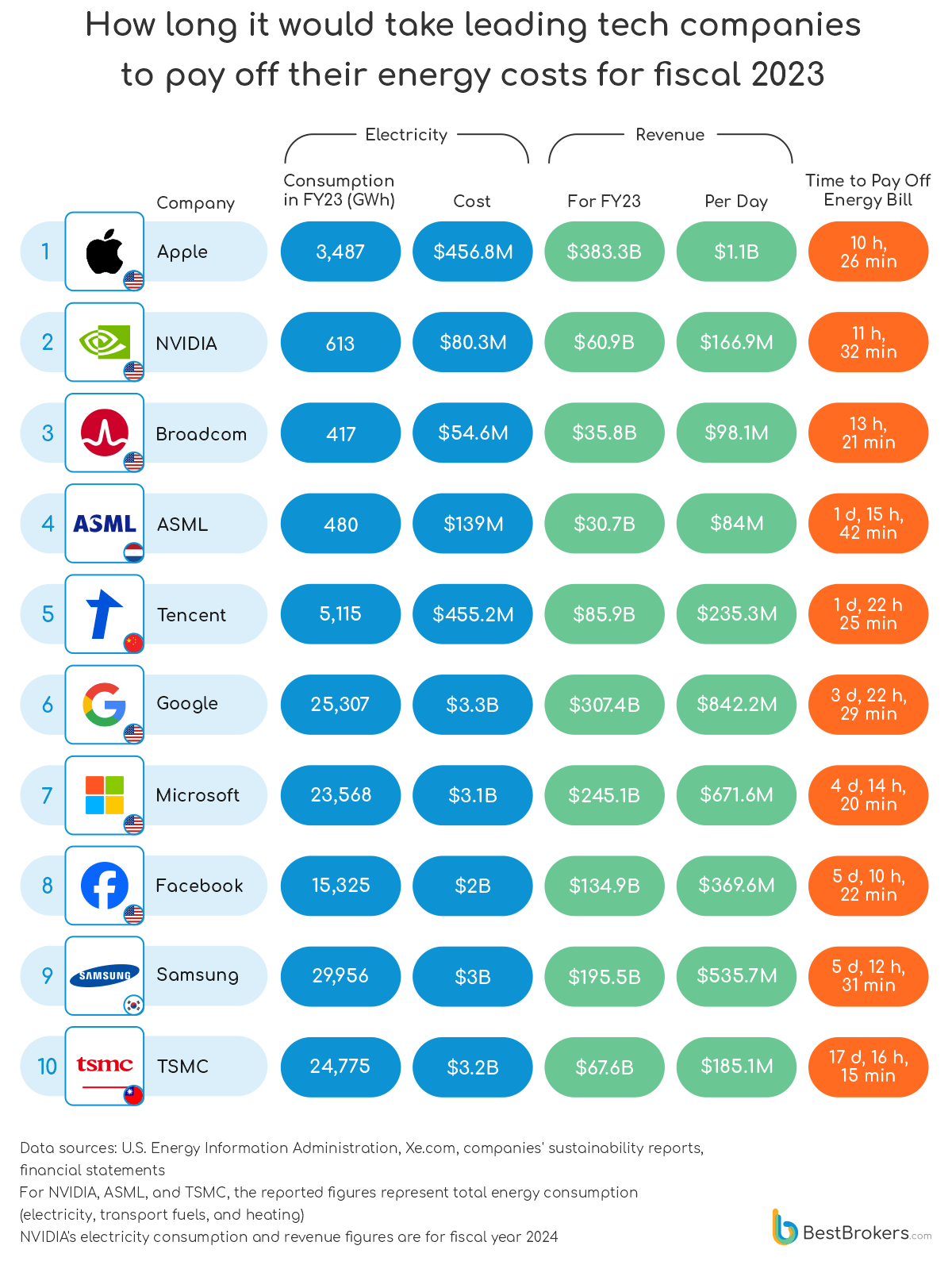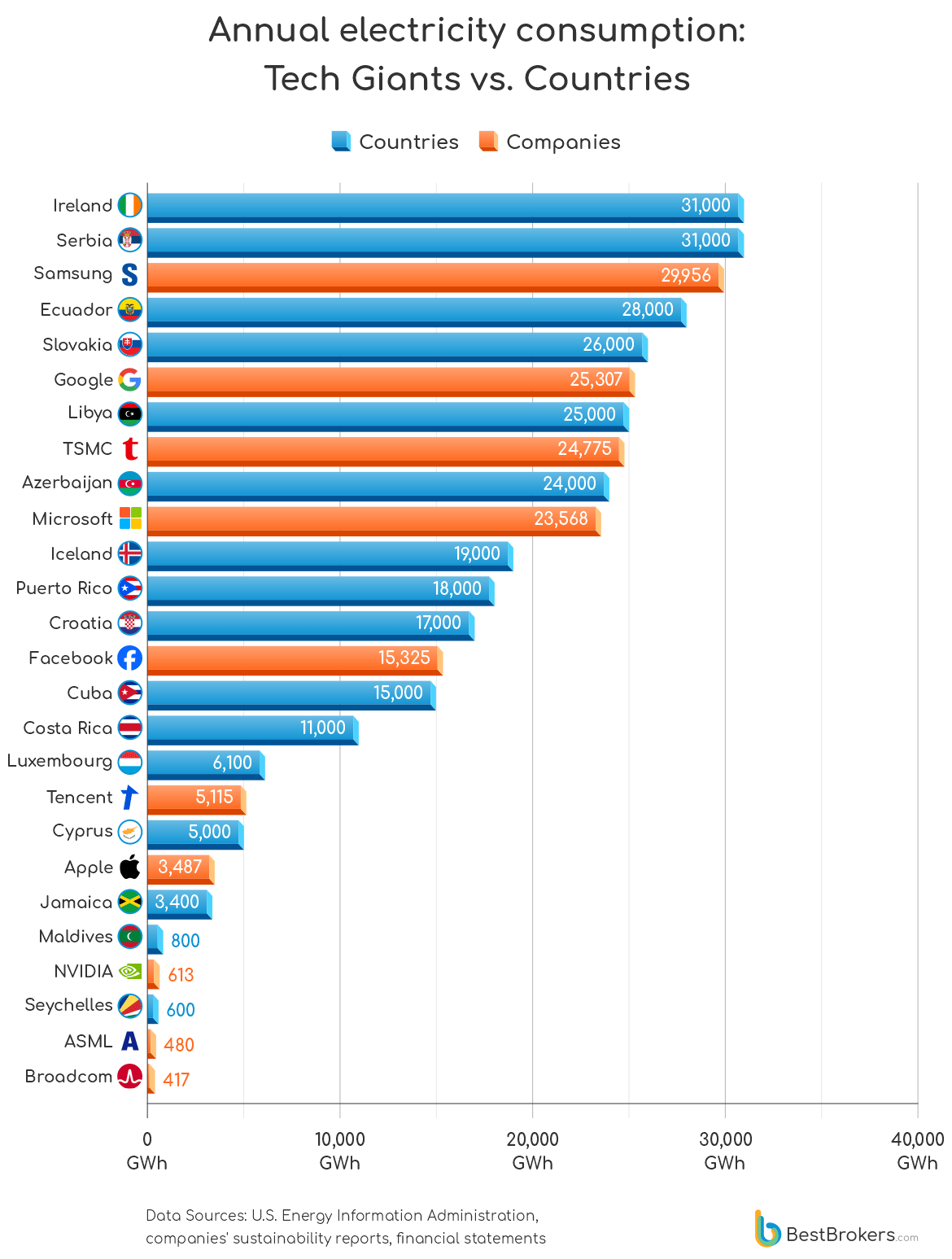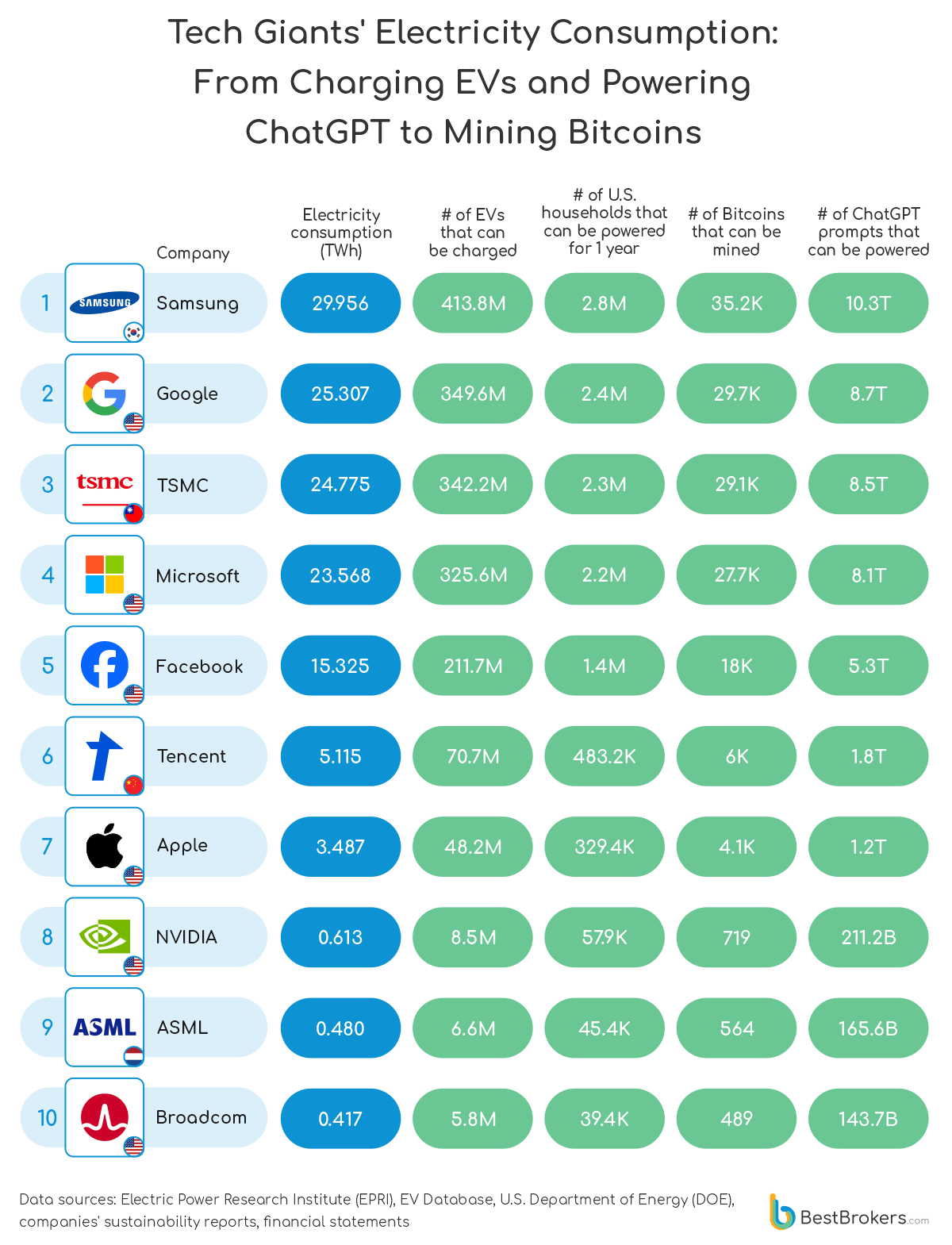In today’s digital world, tech giants such as Apple, Google, Microsoft, and Nvidia power nearly every aspect of our lives. However, behind the digital services and devices we use daily, these tech companies are running sprawling data centres, global offices, and production facilities that consume staggering amounts of energy. In fact, their power consumption is so massive that it often rivals the annual electricity usage of entire countries, raising serious concerns about the environmental impact and the long-term sustainability of their operations.
To illustrate the scale of this energy consumption, the team at BestBrokers analysed the annual electricity usage of the ten largest tech firms by market capitalisation that publicly disclose their power consumption figures. Amazon, Tesla, and Oracle were excluded from our rankings, as they haven’t provided such data in their most recent sustainability reports. We also calculated how much these companies spend on electricity each year and how quickly they could cover that bill using a single day’s worth of revenue.
Our findings reveal that three of the tech companies we looked at could cover their entire annual electricity costs with less than a single day’s revenue. Leading the pack is Apple, which consumed 3,487 gigawatt-hours of electricity during its 2023 fiscal year. Based on the U.S. business electricity rate of $0.131 per kilowatt-hour as of June 2024 (data from the U.S. Energy Information Administration), this amounts to a hefty electricity bill of $456.8 million. However, Apple’s massive revenue of $1.1 billion per day on average allows it to cover these costs in just 10 hours and 26 minutes of operation. This makes Apple’s electricity expenses look like pocket change for a company of its size.

How Fast Tech Giants Can Pay Off Their Annual Power Bills
Besides Apple, Nvidia and Broadcom are also among the fastest tech companies to pay off their power expenses. Nvidia’s electricity consumption surged to 613 gigawatt-hours in fiscal year 2024, up from the 497 gigawatt-hours the year before. This jump, largely driven by the company’s AI work, pushed its electricity bill to $80.3 million. However, with its average revenue of $166.9 million per day, Nvidia can settle its annual energy costs in just half a day of operation. Similarly, Broadcom consumed 417 gigawatt-hours of electricity in 2023, which translates to $54.6 million in electricity expenses. But with an average daily income of $98.1 million, Broadcom can settle its electricity bill in roughly 13 hours.
Google, on the other hand, faces the largest electricity bill among the tech giants we looked at. In 2023, the company used a staggering 25,307 gigawatt-hours of electricity, an increase from the 21,776 gigawatt-hours recorded back in 2022, probably due to the company’s heavy investment in artificial Intelligence. This pushed Google’s electricity costs to a hefty $3.3 billion. Yet, even with such a large bill, Google’s average daily revenue of $842.2 million means it can cover its power expenses in just under four days. Most of Google’s electricity usage in its last fiscal year was consumed by its vast data centres. Interestingly, keeping these centres cool required a staggering 6.1 billion litres of water, which, according to the company, is enough to irrigate 41 golf courses for an entire year.
Samsung tops the list in terms of electricity consumption, using nearly 30,000 gigawatt-hours across its global operations in 2023. This massive energy use resulted in an electricity bill of approximately $3 billion, calculated based on South Korea’s 2023 business rate of 130.76 South Korean won per kilowatt-hour (data from Korea Electric Power Corporation), or around $0.099 per kWh in U.S. dollars. Despite the steep cost, Samsung’s daily profits of $535.7 million on average allow the company to cover its annual power expenses in just over five days and twelve hours.
On the other end of the spectrum, Taiwan Semiconductor Manufacturing Company, the world’s largest chipmaker, faces the longest payback period when it comes to covering its energy costs. Earlier in 2024, Taiwan’s government raised electricity prices, with industrial users seeing an average increase of 13.5%. As a “super-large” consumer using over 15 billion kWh annually, TSMC experienced an even steeper rate hike of 25%. This meant its cost per kilowatt-hour jumped from NT$3.38 to NT$4.23, which is approximately $0.132 in U.S. dollars.
In its most recent fiscal year, TSMC consumed a whopping 24,775 gigawatt-hours of energy, bringing its total bill to $3.2 billion. With an income of $185.1 million per day on average, TSMC would need over 17 days to pay for its power expenses. According to our calculations, these energy costs accounted for about 4.84% of TSMC’s total revenue for the year, with the company using 366,751 kilowatt-hours of electricity for every $1 million in revenue.
To manage the environmental impact and the massive costs that come with their growing electricity consumption, many tech companies are turning to renewable energy and Power Purchase Agreements (PPAs). These long-term contracts allow tech giants to purchase renewable energy directly from producers, securing a steady supply of green power, often at lower rates. Through PPAs, companies can offset their rising energy demands with clean power from sources like wind, solar, and hydropower.
In addition to investing in renewable energy, large tech companies often benefit from preferential electricity rates. Unlike smaller businesses, tech giants can negotiate special pricing because of the jobs they create and the economic boost they provide to the regions where they operate. As a result, their actual energy costs are often far lower than standard business rates.
Tech Companies Use More Electricity Than Entire Nations

To better illustrate the staggering energy demands of some of the world’s largest tech firms, we compared their annual electricity consumption to that of entire nations. In many cases, these power-hungry companies consume as much, if not more, electricity in a single year than countries with populations in the millions.
For instance, Samsung’s electricity consumption of 29,956 gigawatt-hours in its last fiscal year is nearly on par with the annual energy use of entire nations like Ireland and Serbia, each consuming around 31,000 gigawatt-hours, according to the latest U.S. Energy Information Administration data. Remarkably, we found 131 countries and territories, including Ecuador (28,000 GWh) and Slovakia (26,000 GWh), which separately consume less power per year than Samsung.
Even in energy-intensive countries like the United States, which consumes 4,128,000 gigawatt-hours of electricity annually, Samsung’s energy usage in 2023 could power the entire nation for more than two days and a half. In Germany, where annual electricity consumption is around 507,000 gigawatt-hours, the same amount of energy would last for more than three weeks.
Similarly, Google’s electricity consumption of 25,307 gigawatt-hours in 2023 outpaced Libya’s entire annual total of 25,000 gigawatt-hours, a country home to over 7 million people. The amount of power TSMC used in its most recent fiscal year, on the other hand, surpassed Azerbaijan’s yearly electricity consumption of 24,000 gigawatt-hours. Microsoft, with 23,568 gigawatt-hours in annual electricity use, consumed more energy than countries like Jordan (20,000 GWh), Iceland (19,000 GWh), Puerto Rico (18,000 GWh), and Croatia (17,000 GWh).
Meta (formerly Facebook) closely followed with an annual consumption of 15,325 gigawatt-hours, surpassing the electricity usage of countries like Angola, Cuba, Sudan, and Zambia, each consuming around 15,000 gigawatt-hours. Meanwhile, Tencent used 5,115 gigawatt-hours in its last fiscal year, nearly matching the total electricity demand of Brunei (5,200 GWh) and Cyprus (5,000 GWh).
Apple required more electricity than countries like Jamaica and Namibia, while Nvidia consumed 613 gigawatt-hours, an amount roughly equivalent to the annual electricity needs of Bermuda, Greenland, or the Seychelles, each of which uses about 600 gigawatt-hours per year. Meanwhile, ASML and Broadcom reported electricity usage of 480 gigawatt-hours and 417 gigawatt-hours, respectively. These figures exceed the total energy consumption of small island nations such as Haiti and Saint Lucia, both of which use approximately 400 gigawatt-hours annually.
What Else Could That Power Do?
To put the staggering electricity consumption of these tech giants into perspective, let’s see what else could be powered with the energy they use in a single year.

According to the EV Database, the average electric car consumes about 0.191 kilowatt-hours per kilometre and can travel approximately 379 kilometres on a full charge. This means that the average EV battery holds around 72.4 kilowatt hours of energy. If we take Samsung’s electricity consumption of 30 terawatt-hours from last year and divide it by the capacity of an average EV battery, that’s enough energy to fully charge a whopping 413.8 million electric vehicles. In fact, this amount of energy could also charge every EV in the U.S. 125 times. As of the end of 2023, there were about 3.3 million electric cars on American roads. Therefore, charging all these vehicles once would require approximately 238.8 million kilowatt-hours of electricity.
When we look at this from a household perspective, Samsung’s 30 terawatt-hours of electricity usage in 2023 could power 2.8 million U.S. homes for an entire year. This estimate is based on the average American household’s energy consumption of around 29 kWh per day, or about 10,585 kWh annually, according to the Energy Information Administration. While 2.8 million homes are only 2.15% of the 131 million households in the United States, it’s still an impressive amount of energy, especially when you consider that the country ranks third globally in terms of the number of households. Google, by comparison, could power 2.4 million U.S. households for a year with its annual electricity consumption of 25 terawatt-hours.
For Bitcoin enthusiasts, there’s a striking comparison as well. The University of Cambridge’s Bitcoin Electricity Consumption Index shows that global Bitcoin mining consumes about 39.89 terawatt-hours annually, which works out to 383.3 million kilowatt-hours each day. Following the 2024 Bitcoin halving, miners now earn 3.125 Bitcoins for each block they mine. With 144 blocks mined daily (one every 10 minutes), that totals around 450 Bitcoins per day. When we divide the daily electricity consumption for Bitcoin mining by the number of Bitcoins mined each day, we find that it takes about 851,689 kilowatt-hours to mine a single Bitcoin. Based on this calculation, if Samsung devoted its entire annual electricity consumption to mining, it could produce roughly 35,172 Bitcoins in one year. In comparison, Google could mine 29,700 Bitcoins, while TSMC’s annual power usage could yield around 29,100 Bitcoins.
In the world of artificial intelligence, the possibilities are just as impressive. Each query to ChatGPT uses about 2.9 watt-hours of electricity, according to the Electric Power Research Institute. So, Samsung’s electricity consumption of 30 terawatt-hours could power a mind-blowing 10 trillion ChatGPT prompts. Google’s annual energy usage could generate 8.7 trillion responses, while TSMC could power around 8.5 trillion queries.
Methodology
The team at BestBrokers analysed the electricity consumption of the ten largest tech companies by market capitalisation for their most recent fiscal year. Only firms that publicly disclose their energy usage figures were included in this study, which is why Amazon, Tesla, and Oracle were left out. To estimate the costs of each company’s electricity consumption, we used the average electricity rates for 2023-2024 in the countries where they are headquartered. These rates were sourced from or calculated using data provided by national agencies, including the U.S. Energy Information Administration, Korea Electric Power Corporation and Statistics Netherlands. We then converted local electricity rates into U.S. dollars using exchange rates from the XE Currency Converter as of September 18, 2024.
Each company’s daily revenue was calculated by dividing its 2023 annual revenue by 365 days. This allowed us to determine how quickly each company could cover its entire electricity bill using just one day’s worth of revenue. To put these figures into perspective, we compared the companies’ annual energy consumption to that of entire nations based on the latest data from the U.S. Energy Information Administration. We also used various sources to draw equivalencies in terms of electric vehicles, households, Bitcoin mining, and AI operations.
